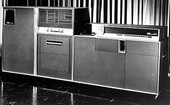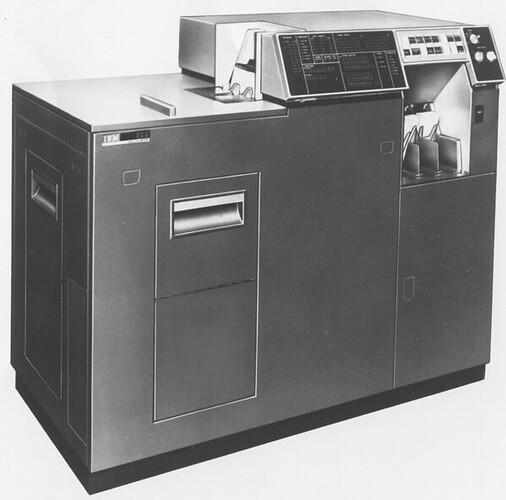Very good observations there!
The more I look at this image, besides that I can’t figure out what those duo-tone units at the left and in the left background are, they don’t appear to contain or to be be part of the CPU, but to be peripherals or storage devices. The cabinet to the right doesn’t look much like a CPU, either, more like memory, or some channel, maybe? (Moreover, this cabinet standing that separated from the other components doesn’t really suggest a central role in this installation.)
Which really leaves the narrow unit behind the operator’s desk as the prime suspect. Could it be that this isn’t a mainframe, at all, but rather one of IBM’s “calculators” (in the 3-digits series)?
(There really doesn’t appear to be much “meat” to this, neither in the operator’s desk, nor to this narrow cabinet in the background.)
Notably, his could provide an explanation for the peculiar, calulator-like 10-column button array on the operator’s desk, which @EdS already observed.
There are some more on bitsavers in the PDF section (but I have currently no time to go through them.) At least some of them seem to have come with peripherals, as well.
Moreover, the entire “air” of this publicity shot may fit a calculator better than the electronic sanctum that were mainframe operations…
Maybe the IBM 1720 pilot system, of which only 3 existed. This was replaced by the 1710.
The CHM has a 1720 reference manual, maybe someone could ask them to see if it has pictures.
Yes, this is very weird.
Probably either a prototype or even a fake/movie props.
The cabinets are early 50s style, the panel including the label on top late 50s or rather early 60s. The 1620 and 1710/1800 have not that label/sign on top, but the 7000s.
The panel is also very small. That can’t be a full mainframe installation.
IBM is well documented. Nothing fits and nothing is even similar.
And is that a laughing lady behind a window on the left?
Cannot unsee. I think I now see the curve in the right window of that leftmost cabinet on the side as a reflection of the left window of the left one at the back of the room. I was previously trying to see it as something circular, like perhaps a drum, but the perspective didn’t fit.
Somehow the other reflections don’t fit. And what about the shadows?
There are at least 2 frontal light sources. And at least one from above
The shadow of the standing man is on the right cabinet.
But there’s another shadow next to his arm. Could be the right cabinet and the head of the sitting man. There’s another darker diagonal shadow. And next to his arm is a light boarder.
The cabinets with the windows look like as if they should be the same. But behind the windows they are different.
Mmm, I’m no longer thinking the circular feature is a reflection of the other window…
I think, this is a carefully arranged and lit publicity shot. There are so many shadows and light sources, and those shadows appear to be much too well defined for them coming from just some ambient ceiling lights (which should be more like areal lights). There’s a light source on top and behind that cabinet on the right, light coming from behind the scene (compare the shadow of the desk and the unit on the left), a strong light from the front right and and even a fill-in from the front left. I can’t think of any natural light that would behave like this.
Also, these are by no means real-life operators, but posing actors. Which also puts some emphasis on how they are posing, like the model on the right “casually” holding of all things a slide rule. This is certainly meant to provide context.
I’d failed to realise that, as a non-user of Twitter, I wouldn’t be seeing any of the replies. Looking over the post again, on twiiit.com or nitter.net, I see the bitsavers account has posted a link to a much much higher resolution version. In which we see that the cabinets are labelled 1601 through to 1605.
See here for example. And the big image, in TIFF format, is here.
Here’s a detail:
Edit: some of the comments from bitsavers:
It is an IBM 1600 system (or 1601 following the conventions of the 1401) boxes left to right 1601, 1602, 1603, 1604, 1606.
http://bitsavers.org/mysteries/ibm1601.tif
…
1606 is the console. box on the left 1608. it sure looks like a process control system given some of the box names
…
if you look closely, there are wide paper tapes on the inside right of the 1601 and 1602. They insides look remarkably similar.
…
Assuming it is tube-based, maybe it ended up being too unreliable and expensive for industrial use.
…
the 1608 looks very similar to the 1712
Edit: more on mastodon
https://oldbytes.space/@bitsavers/111217877858523361
While I’m participating in this stream, this doesn’t show up for me on Twitter (or what Unicode character it is now) – what a frustrating mess.
Most interestingly, bitsavers doesn’t have any info on any 160x series.
Oh look, an IBM 701 photo has the same chair!
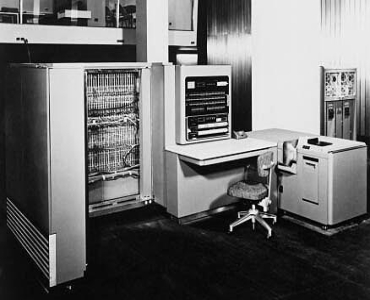
Edit: also this 705 chair in a tweet from Marcin Wichary.
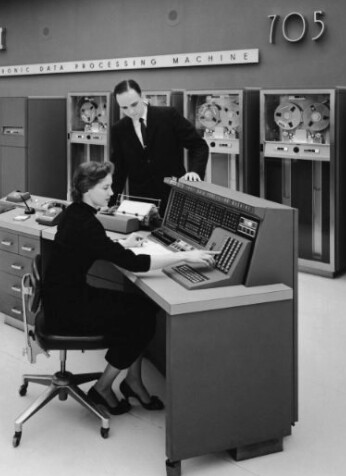
Obviously not sold often, if any. I think we can call this prototypes.
Thanks Ed for solving this. And thanks for nitter. I also wondered if there were answers. And one day earlier I thought we need larger photos as the museum was the only source.
Some of my/our assumptions were right. The lady turned out to be a paper tape, though. I don’t think chairs helping here.
Maybe the chair is a standard IBM chair.
Could be - I was delighted to find a chair match, but also if we hadn’t already got better information, it might have helped rule out many other possibilities. (One commentator elsewhere thought the men’s suits looked Russian, which now seems to be very unlikely.)
The photographer is American and mainly or only took photos in the USA, mainly IBM.
But as the title was wrong, so could be the credit.
It’s still unclear where the larger image was taken from. Did someone contact that museum and asked for it?
I’m not sure if they had a larger print or negative or maybe just a small print (they had 2).
I assumed that that was just for publishing in a newspaper or magazine to announce that new equipment. And it might be possible that it would be a fake and they have been fooled.
And I thought, this was a DEC inventions… ![]()
On the bright side, Ken contacted Dag Spicer, and we may get the various “The PDP-1 at the Tech Model Railroad Club” images fixed. (It hasn’t happened yet, as of writing this.)
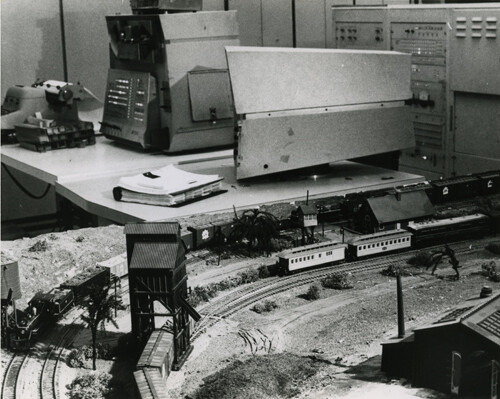
www.computerhistory.org/collections/catalog/102649722
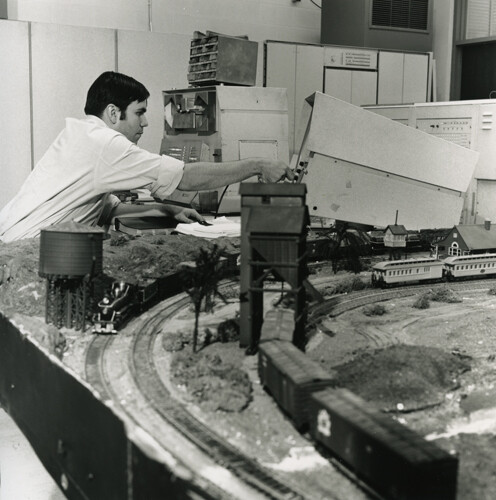
www.computerhistory.org/collections/catalog/102631219
(These are actually showing J.A.N. Lee, then Head of the CS department of the University of Massachusetts, Amherst, operating the PDP-1b production prototype, which had formerly been deployed at BBN and is now, in 1968, “retired” at Amherst, where it is here used to control the local club layout. Compare <Now Go Bang!> Trainspotting (I) and <Now Go Bang!> PDP-1 Spotting - The Amherst Mystery . — Given that only a few PDP-1 were made, it is pretty amazing that two of them had entirely unrelated ties to a university model railroad layout. Given that both the PDP-1 and the layout are somewhat semi-permanent installations, it appears much like that this was now the sole, or at least, prevalent purpose of the PDP-1.)
